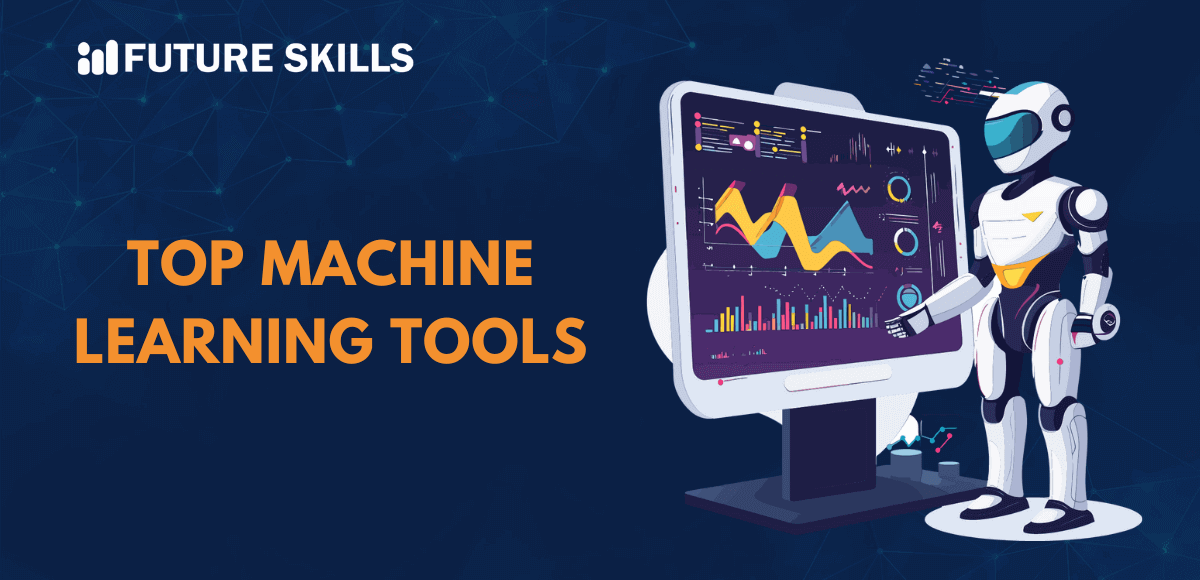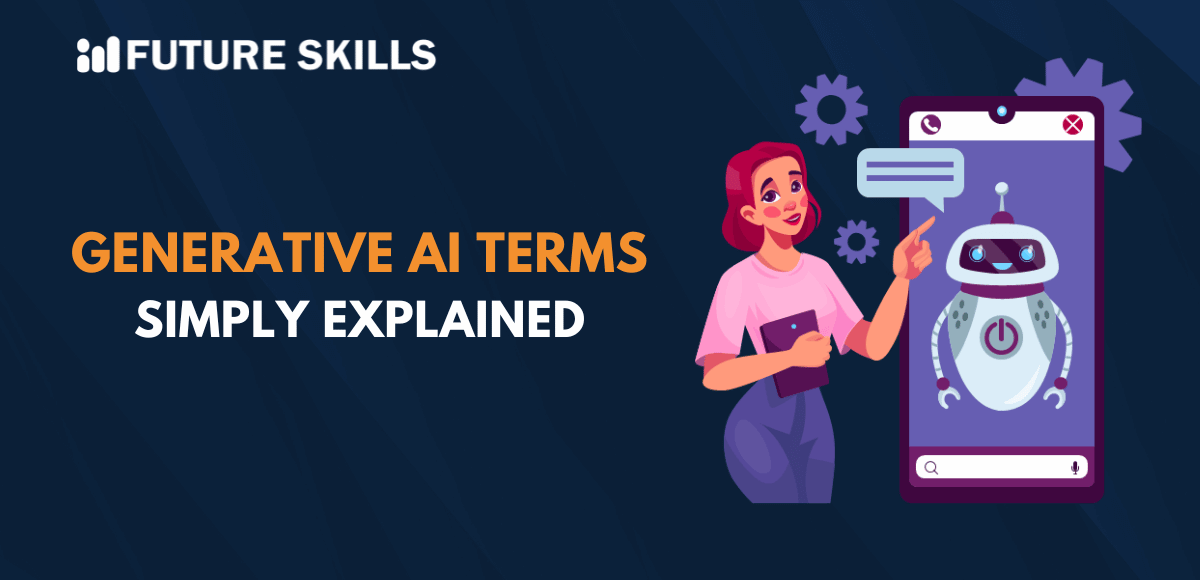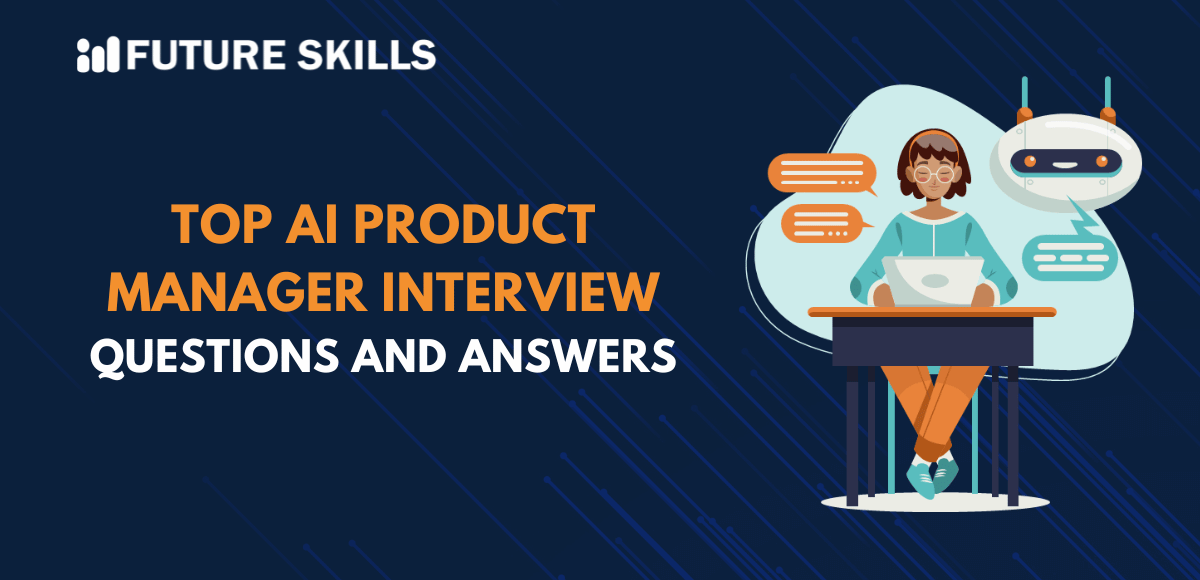Machine learning has changed our conventional assumptions about the possibilities for communication between humans and machines. It is an integral subdomain of artificial intelligence that leverages statistics, massive volumes of data, and a trial-and-error process for learning specific tasks. The interesting thing about machine learning is that it does not need specific programming or instructions to accomplish new tasks. The availability of some of the best machine learning tools helps machine learning engineers create, train, and implement machine learning models at a rapid pace.
With new ML tools emerging every year, it is important to know about the important tools and how they can help you. Machine learning practitioners must also learn about the key traits, strengths, and setbacks of machine learning tools alongside how they have different applications. Let us find out more details about the top machine-learning tools.
Embark on a transformative journey into AI, unlocking career-boosting superpowers through our Certified AI Professional (CAIP)™ Certification program.
What is a Machine Learning Tool?
Machine learning tools are innovative software applications that help computers or machines learn and continuously improve for specific tasks. The tools used in machine learning help systems predict outcomes with better accuracy through analysis of data patterns. You can find different types of ML tools with unique capabilities, and most of them are useful for predictive analytics. The list of machine learning tools includes libraries such as Scikit-learn and comprehensive platforms such as BigML that can offer automation and data-powered insights in different industries.
Why Do You Need Machine Learning Tools?
You might be wondering about the reasons for investing your time and efforts in learning about machine learning tools. How can they help you? The continuously expanding ML tools list creates curiosity regarding their utility. You can give a simple example to help you understand the importance of machine learning tools.
Imagine the efforts required to use machine learning algorithms if you had to create code from scratch. On top of that, many people have stayed away from machine learning because they cannot translate mathematical formulas into code. Interestingly, machine learning tools can help in overcoming such barriers to entry.
Some of the most popular machine learning tools have helped simplify the implementation of machine learning algorithms without technical expertise or mathematical knowledge. While you have to learn the important concepts anyhow, you don’t need them to implement ML algorithms when you have ML tools.
Furthermore, machine learning tools also help in speeding up the process of developing and implementing ML algorithms. Without the need to build code from scratch, you can perform multiple experiments in a limited time, thereby ensuring faster production. ML tools can simplify complex tasks and ensure a faster journey from ideation and research to the production stages.
Level up your ChatGPT skills and kickstart your journey towards superhuman capabilities with Free ChatGPT Course.
What are the Most Effective Machine Learning Tools?
You can find different tools, platforms, and software for machine learning, with new tools emerging every day. However, finding the answer to queries like “Which is the best tool for machine learning?” can be extremely challenging. You have to think of different factors, such as whether the machine learning tool can support the training model of your choice. Here are some of the most notable ML tools that have gained significant improvements in popularity.
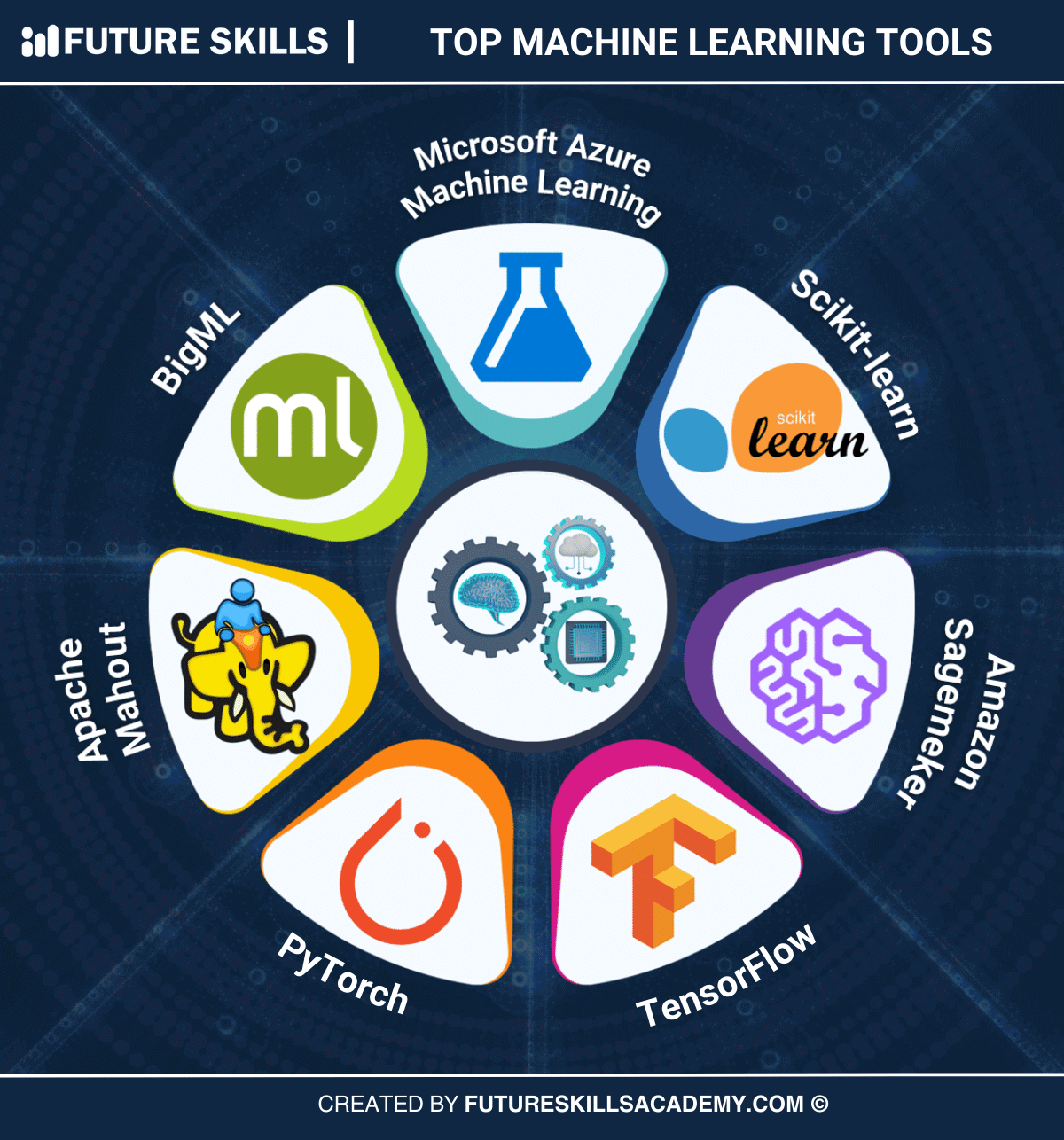
-
Amazon SageMaker
 The first addition among the top machine learning tools that are popular now is Amazon SageMaker. It is a fully managed service tailored for development of machine learning models. Developers can use the platform to develop, train, and deploy machine learning models in one integrated development environment. SageMaker is one of the best machine learning tools that support governance requirements by simplifying access control and enhancing transparency. The notable features of Amazon SageMaker for machine learning include Canvas, Experiments, Data Wrangler, and Clarify.
The first addition among the top machine learning tools that are popular now is Amazon SageMaker. It is a fully managed service tailored for development of machine learning models. Developers can use the platform to develop, train, and deploy machine learning models in one integrated development environment. SageMaker is one of the best machine learning tools that support governance requirements by simplifying access control and enhancing transparency. The notable features of Amazon SageMaker for machine learning include Canvas, Experiments, Data Wrangler, and Clarify.
The notable benefits of SageMaker as a ML tool include the support for multiple frameworks and flexibility for choosing ML tools. For example, users can determine whether they need IDEs or a no-code interface, depending on their programming skills. On top of it, SageMaker also helps you deploy ML models trained with the help of third-party frameworks such as Scikit-learn, PyTorch, and TensorFlow.
-
Scikit-learn
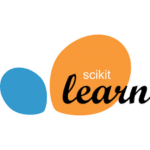 Scikit-learn is also a credible addition among ML tools that can make machine learning easier for new practitioners. It is the most common addition to any machine learning tools list for its unique features. Scikit-learn serves as the best open-source library for machine learning in the Python ecosystem. The library has gained popularity for offering a user-friendly and simple interface along with an extensive collection of unsupervised and supervised learning algorithms.
Scikit-learn is also a credible addition among ML tools that can make machine learning easier for new practitioners. It is the most common addition to any machine learning tools list for its unique features. Scikit-learn serves as the best open-source library for machine learning in the Python ecosystem. The library has gained popularity for offering a user-friendly and simple interface along with an extensive collection of unsupervised and supervised learning algorithms.
Scikit-learn stands out for offering the best features of other popular libraries, such as matplotlib, NumPy, and SciPy. Therefore, it is the first pick for data mining and analysis. On top of that, Scikit-learn offers an extensive collection of algorithms suitable for dimensionality reduction, classification, clustering, and regression. The library also offers productive tools for selecting, evaluating, and preprocessing ML models. Most important of all, it offers comprehensive documentation alongside the benefits of community support.
Enroll now in the AI for Business Course to understand the role and benefits of AI in business and the integration of AI in business.
-
Microsoft Azure Machine Learning
 Another top player among ML tools is Microsoft Azure Machine Learning. It serves as a fully managed cloud service that can support development, deployment, and management of the lifecycle of machine learning projects. Microsoft Azure Machine Learning is probably the best answer to “Which is the best tool for machine learning?” for its effectiveness in faster development of machine learning models. The platform improves time to market with integrated tools, machine learning operations, and open-source interoperability. Microsoft Azure Machine Learning has also been designed with priority to responsible AI.
Another top player among ML tools is Microsoft Azure Machine Learning. It serves as a fully managed cloud service that can support development, deployment, and management of the lifecycle of machine learning projects. Microsoft Azure Machine Learning is probably the best answer to “Which is the best tool for machine learning?” for its effectiveness in faster development of machine learning models. The platform improves time to market with integrated tools, machine learning operations, and open-source interoperability. Microsoft Azure Machine Learning has also been designed with priority to responsible AI.
One of the most appealing features of Microsoft Azure ML is the flexibility for rapid iteration of data preparation by utilizing Apache Spark clusters. In addition, it offers interoperability with Azure Databricks. Developers can also utilize integrated tools such as Visual Studio Code and Jupyter Notebooks for collaboration. The Designer drag-and-drop interface in Microsoft Azure ML offers a simple interface to create machine learning pipelines. On top of that, developers can also leverage the benefits of in-build governance, compliance, and security to execute machine learning workloads from anywhere.
-
TensorFlow
 The list of notable tools used in machine learning would be incomplete without TensorFlow. It is an end-to-end open-source ML platform by Google. TensorFlow focuses primarily on training deep neural networks alongside a collection of tools and libraries such as TensorFlow Serving. TensorFlow also offers valuable resources for implementing solutions for natural language processing, predictive machine learning, computer vision, and reinforcement learning.
The list of notable tools used in machine learning would be incomplete without TensorFlow. It is an end-to-end open-source ML platform by Google. TensorFlow focuses primarily on training deep neural networks alongside a collection of tools and libraries such as TensorFlow Serving. TensorFlow also offers valuable resources for implementing solutions for natural language processing, predictive machine learning, computer vision, and reinforcement learning.
The distinctive features of TensorFlow include support for distributed computing that can enable training of ML models with different machines. Developers can also use GPU or TPU acceleration to increase the pace of training. Another distinctive feature of TensorFlow that makes it one of the most popular machine-learning tools is the TensorBoard. It is a unique visualization tool that helps developers visualize their ML models. TensorFlow also offers pre-built models for different use cases with the flexibility of deploying them on different platforms.
-
Apache Mahout
 Apache Software Foundation has created Apache Mahout with unique features. It is a mathematically expressive domain-specific language and an open-source distributed linear algebra framework. The framework has been designed for data scientists, mathematicians, and statisticians. It helps in faster development of efficient and scalable machine learning algorithms.
Apache Software Foundation has created Apache Mahout with unique features. It is a mathematically expressive domain-specific language and an open-source distributed linear algebra framework. The framework has been designed for data scientists, mathematicians, and statisticians. It helps in faster development of efficient and scalable machine learning algorithms.
Apache Mahout also offers the unique advantage of using tested algorithms to solve common problems in different industries. Another unique advantage of Apache Mahout is the scalability of large datasets, which can be distributed throughout large data center clusters working on Apache Hadoop. As a result, developers can have a distributed and highly scalable framework that can handle large volumes of data.
-
PyTorch
 The collection of top open-source ML tools also includes PyTorch. It is an optimized tensor library that helps in developing deep learning models by leveraging CPUs and GPUs. PyTorch is one of the best machine learning tools for distributed training that enables developers to optimize performance at the research and production stages. PyTorch offers exclusive support for peer-to-peer communication and asynchronous execution of collective operations.
The collection of top open-source ML tools also includes PyTorch. It is an optimized tensor library that helps in developing deep learning models by leveraging CPUs and GPUs. PyTorch is one of the best machine learning tools for distributed training that enables developers to optimize performance at the research and production stages. PyTorch offers exclusive support for peer-to-peer communication and asynchronous execution of collective operations.
The unique tools offered by PyTorch, such as TorchScript and TorchServe, are also important for machine learning practitioners. TorchScript enables the development of serializable and optimizable models with PyTorch code, thereby ensuring that they are production-ready. On the other hand, TorchServe helps deploy PyTorch models easily and at a large scale. PyTorch also offers native ONXX support, which enables the export of models in standard ONXX format. As a result, models are directly accessible on ONXX-compatible runtimes, visualizers, and platforms.
-
BigML
 As the name implies, BigML is a big player in the domain of ML tools. It is a unique addition to any ML tools list for its comprehensive range of features. It is a cloud-based, scalable, and programmable ML platform that enables easier development of machine learning models. Machine learning practitioners can access different services, such as data preparation, model creation, and data visualization.
As the name implies, BigML is a big player in the domain of ML tools. It is a unique addition to any ML tools list for its comprehensive range of features. It is a cloud-based, scalable, and programmable ML platform that enables easier development of machine learning models. Machine learning practitioners can access different services, such as data preparation, model creation, and data visualization.
The most impressive feature of BigML is the easier automation of complicated machine learning procedures. It can also save money by connecting with the BigML REST API. All the predictive models on BigML feature interactive visualizations and features to explain them. It also offers the advantage of exportable models that can offer local, offline predictions or instant deployment in a distributed real-time application.
Excited to understand the crucial requirements for developing responsible AI and the implications of privacy and security in AI, Enroll now in the Ethics of Artificial Intelligence (AI) Course.
How Can You Find the Right Machine Learning Tools?
The quest to find answers to “Which is the best tool for machine learning?” can lead you to different options. However, it is important to remember that there is no one-size-fits-all solution among machine learning tools. You can find the right machine-learning tool by evaluating your needs. It is important to consider factors such as your goals, desired level of customization, and constraints. Each machine learning tool has unique capabilities, and you must find out how to use them in the right place.
TensorFlow supports improvements in notable areas of machine learning alongside promoting an in-depth understanding of deep learning. On the other hand, PyTorch offers speed and flexibility for creating deep learning models. You must choose ML tools that help you make the process simple.
Final Words
Machine learning is the lifeblood of AI systems that have revolutionized digital transformation across different industries. The best way to find your way into the world of machine learning involves choosing the right ML tool. The best machine learning tools can help you develop, deploy, and manage machine learning models. It is important to remember that every machine-learning tool has its unique specialty.
Therefore, it is important to identify your goals, constraints, and level of customization for developing ML models to find the ideal ML tools. The primary advantage of machine learning tools is that they encourage innovation in the field of AI. Learn more about the fundamentals of machine learning and build your credibility as a machine learning expert right away.

